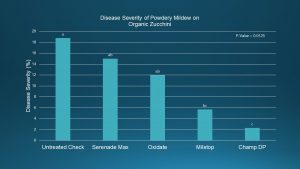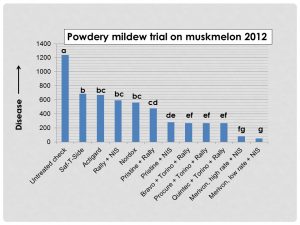In a separate article in this issue, I discussed management of powdery mildew with conventional fungicides. Here I would like to talk about powdery mildew management of cucurbits with organically approved products. I will describe two studies, one with all organically approved products and a second with a combination of organic and conventional products. All studies were conducted at the SW Purdue Ag Center in Vincennes, IN.
The organic products discussed are defined as organic since they appear on the Organic Material Review Institute (OMRI). There are other certifying agencies. Be sure to check with your certifying agency before using any fungicide product. As an example, the Champ DP® product used in 2010 is listed by OMRI as approved. However, Champ WP® is not.
In the 2010 study shown below, zucchini of the variety Raven F1 were planted in the certified organic plot managed at the SW Purdue Ag Center. Organic products were applied using a CO2 backpack sprayer from 22 Jul to 31 Aug. Each product was applied one time per week except for Oxidate® which was applied twice weekly. The reason Oxidate was applied twice a week is that the active ingredient, hydrogen dioxide, has little or no residue to remain on the plant surface after the product has dried.
Only the Champ® and Milstop® treatment had significantly less powdery mildew than the untreated check (Figure 1). The Oxidate® and Serenade Max® treatments were not significantly different than the untreated check.

Figure 1: Powdery mildew management on zucchini with organic products. Treatments with a letter in common are not significantly different at the 5% level (LSD).
By the criteria used in most agricultural trials, there was no significant difference in total yields. However, for the yields of 1 Sep, there were differences at the 10% level (most agricultural studies require differences at the 5% level). On 1 Sep, the Champ® treatment had 1,525 fruit per acre, significantly more than the Milstop®, Oxidate® or the untreated check. The Champ® and Serenade Max® treatments were not significantly (data not shown).
The copper product, Champ DP®, outperformed all the other organically certified treatments in this trial. It is important to note that the Oxidate® treatment did not match the Champ® treatment even when applied twice a week. While Oxidate® can disinfest the surface of plants, the absence of any residue makes it an inferior treatment in this situation.
The second figure is from a cantaloupe study in 2012. The study was conducted in a conventional plot. Fungicides were applied with hollow cone nozzles with 30 PSI using a 3-point hitch one row sprayer. Saf-T-Side® and Nordox® are both organically certified. Nordox® is a cuprous oxide (copper) product. Saf-T-Side® contains petroleum oil. The trial is published here.

Figure 2: Management of powdery mildew of cantaloupe with organic and conventional products. Note that two products separated with a ‘+’ are alternated with each other. Treatments with a letter in common are not significantly different at the 5% level.
All of the treatments had significantly less powdery mildew than the untreated check. The disease levels of the Saf-T-Side® and Nordox® treatments were not significantly from each other; the Nordox® disease level was not different from the Rally® or Pristine®/Rally® treatments. The remaining treatments: Bravo®/Torino®/Rally®, Procure®/Torino®/Rally®, Quinec®/Torino®/Rally® and two rates of Merivon® all had significantly less powdery mildew than the organic treatments or the untreated check.
The untreated check was not significantly different in yield in lb/A than any other treatment except the Merivon low rate (data not shown). The low rate of the Merivon® treatment had significantly higher yield than the untreated check or the Actigard® treatment. The latter treatment had the lowest yield of any treatment, significantly less than any treatment except the untreated control.
Lessons to be learned from the 2012 trial includes:
- The two organic treatments, Saf-T-Side® and Nordox®, had significantly lower powdery mildew levels than the untreated check and not significantly different than the Actigard® or Pristine®/Rally® treatment.
- Actigard®, if used all season long, may reduce marketable yield and is not an effective powdery mildew product.
- As noted in my previous blog, Pristine® may not be an effective powdery mildew product in Indiana anymore.
- The treatments with 3 products in alternation and the two Merivon treatments managed powdery mildew well.
As always, please don’t hesitate to contact me with any questions or concerns.
This article also appears in the blog veggiediseaseblog.org.